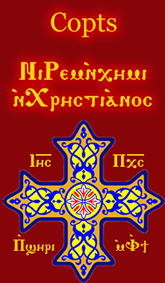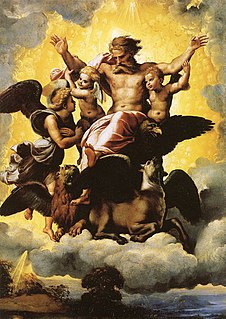Anaphora
The anaphora included in the Barcelona Papyrus was first published by Ramón Roca-Puig in 1994, [2] and the critical edition was issued by M. Zheltov in 2008. [1] This anaphora, which could be related to some Pachomian monastery, was a form well known in Egypt before about the 7th century: in fact other two fragments of it have been recovered: the so-called Louvain Coptic Papyrus, a Coptic version dating from the 6th century, [3] and the Greek fragment PVindob. G 41043. [4]

The Anaphora is the most solemn part of the Divine Liturgy, or the Holy Sacrifice of the Mass, during which the offerings of bread and wine are consecrated as the body and blood of Christ. This is the usual name for this part of the Liturgy in Greek-speaking Eastern Christianity. In western Christian traditions which have a comparable rite, the Anaphora is more often called the Roman Canon in the Latin liturgy, or the Eucharistic Prayer for the three additional modern anaphoras. When the Roman Rite had a single Eucharistic Prayer, it was called the Canon of the Mass.

Coptic, or Coptic Egyptian, is the latest stage of the Egyptian language, a northern Afro-Asiatic language spoken in Egypt until at least the 17th century as an official language. Egyptian began to be written in the Coptic alphabet, an adaptation of the Greek alphabet with the addition of six or seven signs from Demotic to represent Egyptian sounds the Greek language did not have, in the 1st century AD.
The anaphora of Barcelona includes all the typical elements of a developed anaphora, with the particularity that its epiclesis is placed before the Words of Institution, as in the Roman Canon and in the Anaphora of Deir Balyzeh. [5] The content of this anaphora, which includes no Intercessions, is the following: [1] :493

The epiclesis is the part of the Anaphora by which the priest invokes the Holy Spirit upon the Eucharistic bread and wine in some Christian churches.

The Words of Institution are words echoing those of Jesus himself at his Last Supper that, when consecrating bread and wine, Christian Eucharistic liturgies include in a narrative of that event. Eucharistic scholars sometimes refer to them simply as the verba.
The text and rubrics of the Roman Canon have undergone revisions over the centuries, while the Canon itself has retained its essential form as arranged no later than the 7th century. The text consists of a succession of short prayers with no clear sequence of thought. The rubrics, as is customary in similar liturgical books, indicate the manner in which to carry out the celebration.
- Opening Dialogue,
- Preface which praises the Father for the creation of heaven and earth, the sea and all that is in them (quoting Psalm 146:6 as usual in the Alexandrine anaphoras [6] ), and which next praises also Christ,
- Sanctus, without the Benedictus as usual in early Egypt and introduced by a Pre-Sanctus,
- Post-Sanctus centered on Christ,
- Oblation, offering the bread and the cup,
- an Epiclesis directed to the Holy Spirit, with an explicit request to change the bread and wine into the Body and Blood of Christ,
- a short Institution narrative followed by the Anamnesis,
- a petition for worthy Communion which could be considered as a second or implicit epiclesis,
- final Doxology.
In liturgical use the term preface is applied to that portion of the Eucharistic Prayer that immediately precedes the Canon or central portion of the Eucharist. The preface, which begins at the words, "It is very mete and just, right and salutary" is ushered in, in all liturgies, with the Sursum Corda, "Lift up your hearts", and ends with the Sanctus, "Holy, Holy, Holy, etc."

God the Father is a title given to God in various religions, most prominently in Christianity. In mainstream trinitarian Christianity, God the Father is regarded as the first person of the Trinity, followed by the second person God the Son and the third person God the Holy Spirit. Since the second century, Christian creeds included affirmation of belief in "God the Father (Almighty)", primarily as his capacity as "Father and creator of the universe". However, in Christianity the concept of God as the father of Jesus Christ goes metaphysically further than the concept of God as the Creator and father of all people, as indicated in the Apostle's Creed where the expression of belief in the "Father almighty, creator of heaven and earth" is immediately, but separately followed by in "Jesus Christ, his only Son, our Lord", thus expressing both senses of fatherhood.

The Sanctus is a hymn in Christian liturgy. It may also be called the epinikios hymnos when referring to the Greek rendition.
The liturgical scholar Paul F. Bradshaw suggests that this anaphora reached its final form in the 4th century, adding the Sanctus, as well as the Epiclesis and the Institution narrative, to a more ancient material, which could more likely derive from West Syria rather than from Egypt. [6]
Paul Frederick Bradshaw, FRHistS is a British Anglican priest, theologian, historian of liturgy, and academic. In addition to parish ministry, he taught at Chichester Theological College and Ripon College Cuddesdon. From 1985 to 2013, he was Professor of Liturgy at the University of Notre Dame in the United States.

Anointing of the sick, known also by other names, is a form of religious anointing or "unction" for the benefit of a sick person. It is practiced by many Christian churches and denominations.

Mass is a term used to describe the main eucharistic liturgical service in many forms of Western Christianity. The term Mass is commonly used in the Catholic Church and Anglican churches, as well as some Lutheran churches, Methodist, Western Rite Orthodox and Old Catholic churches.

Divine Liturgy or Holy Liturgy is the Eucharistic service of the Byzantine Rite, developed from the Antiochene Rite of Christian liturgy which is that of the Ecumenical Patriarchate of Constantinople. As such, it is used in the Eastern Orthodox, the Greek Catholic Churches, and the Ukrainian Lutheran Church. Although the same term is sometimes applied in English to the Eucharistic service of Armenian Christians, both of the Armenian Apostolic Church and of the Armenian Catholic Church, they use in their own language a term meaning "holy offering" or "holy sacrifice". Other churches also treat "Divine Liturgy" simply as one of many names that can be used, but it is not their normal term.
The Sacramentary of Serapion of Thmuis is a work of Saint Serapion, or Sarapion, bishop of Thmuis in the Nile Delta and a prominent supporter of Athanasius in the struggle against Arianism. He is best known in connection with this prayer-book or sacramentary intended for the use of bishops.
Christian liturgy is a pattern for worship used by a Christian congregation or denomination on a regular basis. Although the term liturgy is used to mean public worship in general, the Byzantine Rite uses the term "Divine Liturgy" to denote the Eucharistic service.

The Roman Rite is the most widespread liturgical rite in the Catholic Church, as well as the most popular and widespread Rite in all of Christendom, and is one of the Western/Latin rites used in the Western or Latin Church. The Roman Rite gradually became the predominant rite used by the Western Church. Many local variants, not amounting to distinctive Rites, existed in the medieval manuscripts, but have been progressively reduced since the invention of printing, most notably since the reform of liturgical law in the 16th century at the behest of the Council of Trent (1545–63) and more recently following the Second Vatican Council (1962–65).

In keeping with its prevailing self-identity as a via media or "middle path" of Western Christianity, Anglican sacramental theology expresses elements in keeping with its status as a church in the Catholic tradition and a church of the Reformation. With respect to sacramental theology the Catholic tradition is perhaps most strongly asserted in the importance Anglicanism places on the sacraments as a means of grace, sanctification and forgiveness as expressed in the church's liturgy.
The Alexandrian Rite is the liturgical rite used by the Coptic Orthodox Church of Alexandria, Eritrean Orthodox Tewahedo Church and Ethiopian Orthodox Tewahedo Church, as well as by the three corresponding Eastern Catholic Churches.
The Liturgy of Saint Basil or, more formally, the Divine Liturgy of Saint Basil the Great, is a term for several Eastern Christian celebrations of the Divine Liturgy (Eucharist), or at least several anaphoras, which are named after St. Basil the Great. Two of these liturgies are in common use today: the one used in the Byzantine Rite ten times a year, and the one ordinarily used by the Coptic Church.
Gnosticism used a number of religious texts that are preserved, in part or whole, in ancient manuscripts, or lost but mentioned critically in Patristic writings.
The Anaphora of the Apostolic Tradition, also known as the Anaphora of Hippolytus, is an ancient Christian Anaphora which is found in chapter four of the Apostolic Tradition. It should not be confused with the Syriac Orthodox Anaphora of the Twelve Apostles, which is similar, and may be one of several liturgies derived from this Anaphora, yet is considerably longer and more ornate.
The Strasbourg papyrus is a papyrus made of six fragments on a single leaf written in Greek and conserved at the Strasbourg National University Library, cataloged Gr. 254. It was first edited in 1928. The Strasbourg papyrus contains an ancient Christian prayer, probably an Anaphora, similar to the first part of the Alexandrine Anaphora of Saint Mark. The Papyrus was probably written in the fourth or fifth century, but it may present an older text, resulting to be one of the older Eucharistic Prayer known.
The Fundación Sant Lluc Evangelista, was founded in 1952, in Barcelona, by Ramón Roca Puig (1906–2001), Spanish papyrolog and priest from Catalonia, who several times travelled to the Near East, where acquired some important ancient manuscripts.

The Liturgy of Addai and Mari is the Divine Liturgy belonging to the East Syriac Rite and was historically used in the Church of the East. This liturgy is traditionally attributed to Saint Addai and Saint Mari. It is currently in regular use, even if in different versions, in the Assyrian Church of the East, the Ancient Church of the East, the Syro-Malabar Catholic Church, and the Chaldean Catholic Church. The latter two are Eastern Catholic churches in full communion with the Holy See of Rome.
The Deir Balyzeh Papyrus is a 6th-century papyrus, coming from Egypt. It contains early fragmentary Christian texts: three prayers, a short creed and a portion of Anaphora.

The Liturgy of Saint Cyril is one of the three Anaphoras used at present by the Coptic Orthodox Church and it retains the liturgical peculiarities which have originated in the early Christian Egypt, thus forming the core of the historical Alexandrian Rite. When reference is made to its Greek version, this text is usually known as Liturgy of Saint Mark.
The Liturgy of Saint Gregory the Theologian is one of the three Anaphoras retained by the Coptic Church. The text is named after Saint Gregory of Nazianzus, one of the Cappadocian Fathers.













